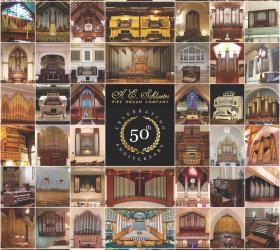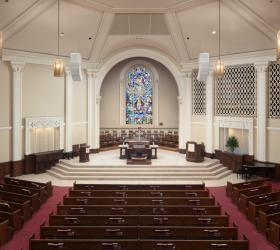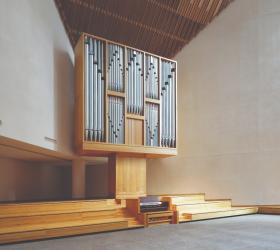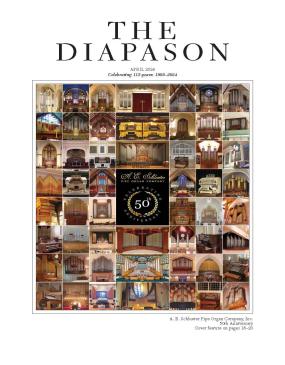
From the organbuilder
It has been a high honor for me and my firm to design and build this new three-manual pipe organ for the St. Vincent Archabbey Basilica. The new Gallery Organ of 51 stops and 72 ranks of pipes was installed beginning in July 2014 and completed in October, having spent the previous two years in construction. The basilica is home to St. Vincent Archabbey, the oldest American Benedictine monastery, St. Vincent Parish, St. Vincent College, a four year co-educational institution, and St. Vincent Seminary.
This organ is the culmination of 18 years of thought, prayer, vision, and tenacity on the parts of the Benedictine community and the organbuilder. Nearly 20 years ago, I was asked to provide consulting services to address the failing organ previously installed in the basilica. The need for a new organ had become apparent to most all the monks because of the old organ’s deteriorated mechanical condition, but its greatest flaw was that the former instrument was tonally only about 30 percent as large as would be required to fill this large building with a wide variety of tone colors and volume levels. Abbey Organist and Choir Director Rev. Cyprian Constantine, OSB, embarked on a tireless effort to educate his confreres and superiors to what was really required, if sacred music at the abbey, parish, college, and seminary were to be taken to the highest level.
Following the old organ’s demise, use of an electronic instrument gave the community the time to raise the funds to begin construction. Sufficient funds had been raised from the parish in a previous campaign to allow us to design and construct a small Apse Organ and a console, which would control both it and the planned-for Gallery Organ. The Apse Organ is installed in two small chambers carved out of the sacristy behind the apse and utilizes the best pipework from the previous organ as well as new stops. From its installation in 2007 until the new Gallery Organ arrived, the Apse Organ accompanied the college’s choral ensembles and monastic services in the Great Choir; the electronic instrument was used for parochial Masses and services in the nave.
When it was determined to proceed with the Gallery Organ, the budget allocated for it 18 years previously was insufficient for the complete instrument and could not be increased. We had a dilemma on our hands: if we built an organ to simply accommodate the budget, it would repeat the past mistake of being too small for the basilica’s heroic size, volume, and the musical requirements placed upon an instrument in such an important and enormous place. So, we decided to build an organ with the infrastructure of a complete instrument of the correct size, installing the Great, Swell, and Pedal, but preparing the Choir division for future addition. This would provide the abbey with heroic bodies of sound to support the liturgical needs and accommodate a goodly body of the solo organ literature. The prepared-for Choir division will include a wide variety of softer orchestral reed colors and flue choruses for more registrationally involved choral accompaniments, and will act as a secondary foil to the Great for playing solo literature requiring three independent manual divisions. Currently a single console controls both organs. A second gallery console is also prepared for future addition for recitals and solo work, so the organist doesn’t have to suffer the delay of sound reaching his ears—while playing in real time—as at present.
Architecturally, the gallery posed a challenge: the gallery is not large, nor is the wheel window located high enough up on the wall to allow a generous configuration of pipes and their mechanical systems to live under it. Additionally, we were instructed that the organ must be located entirely in the gallery with no pipes over the rail. After reviewing the many drawings I had made during past years, Rev. Vincent Crosby, OSB, the abbey’s resident artistic director, suggested that he simply wanted to see pipes in the gallery, with only the amount of casework necessary to support them. This general direction and a rough sketch was the genesis for the visual design.
The Great division is split into two windchests located just behind the front of each of the large façade pipe groupings. The Swell is located on the right; the prepared-for Choir division will be on the left. The large 32′ and 16′ Pedal Trombone resonators and the 16′ Double Open Diapason basses are made of wood so that they can lie down under the window, with the remaining Pedal stops, the Solo Tubas and Trombas standing vertically under and around the window. The large façade pipes are all made of copper-lined polished tin, comprising the Pedal 16′ First Open Diapason, the continuation of the Great 16′ Double Open Diapason from the wood basses behind, the Pedal 8′ Principal, and the Great 8′ First and Second Open Diapasons. The smaller façade pipes in the central display are from the Pedal 4′ Open Flute. The largest pipe in the façade, low CCC of the 16′ Pedal First Open Diapason weighs over 350 pounds and required six men to hoist into the gallery; the smallest pipe’s speaking length is only an eighth of an inch. The metal pipes were all made in
the south of Germany, coincidental to the south German heritage of St. Vincent Archabbey.
The decorations on the cases’ woodworking take their cues from the painted decorations in the colonnades in the basilica. These include 24-karat red-gold-leafed interlocking rings on a deep green background between maroon and gold-leaf striping, with blue enameled rosettes with gold-leaf highlights centered in each ring. Although the lower portion of the case cannot be seen from the main floor, being blocked by the solid balcony rail, it is made of 1½′′-thick solid white oak, incorporating Romanesque arches in each panel opening, stained and finished to match the other woodworking in the basilica.
John-Paul Buzard’s tonal style is easy to describe, but the most difficult to carry out successfully: “classically symphonic” (a term coined by a reviewer in The Diapason), Buzard organs intend to play music from every historical and nationalistic school with musical éclat and flair. (A bold statement, to be certain!) The challenge in achieving success in this difficult style is how to create an instrument that plays most everything, yet has its own singular and very individual artistic character. But, because we are Americans in the 21st century, I believe that our liturgical and concert organs need to be able to play everything. Therefore, every historic and nationalistic style of organbuilding is represented to some degree in each Buzard organ, but interspersed through the instrument evenly so that a balanced eclecticism is achieved. We don’t create this by building entire divisions of the organ in single styles as many do: a German Great, a French Swell, an English Choir, for example. The reason that we could in good conscience prepare the Choir division for the future is because of this even-handed dispersion of the style of the stops’ construction and voicing. When the Choir division is installed, then this instrument will be a complete artistic achievement. Although this organ is currently very impressive sounding, I liken it to a tapestry that is missing a color or two of embroidery.
The sumptuous acoustical environment of the basilica allowed us to truly freely exercise our voicers’ art. The St. Vincent Archabbey Basilica has, at its maximum, a reverberation time of 6.5 seconds; bass frequencies are nicely amplified by means of hard reflective surfaces on the walls, floor, and ceiling. This allowed us to achieve the rare effect that depending upon the piece of music played, you can easily imagine yourself in Paris, Haarlem, or York Minster!
The organ was dedicated in a solemn service and concert on Sunday, November 23, 2014. Our own tonal associate, Jonathan Young, filled in for Father Cyprian Constantine, OSB, as recitalist, due to Father Cyprian’s need for emergency retinal surgery. Everyone on the staff of Buzard Pipe Organ Builders brings his or her own individual talents to the family table (although not every one of us can sit down and play a concert with two weeks’ notice!). And a new generation of organbuilders is being nurtured at the Buzard shop, as you will note in the “Here and There” column of this issue of The Diapason.
Deepest thanks to Father Cyprian Constantine, OSB, Father Donald Raila, OSB, Father Stephen Concordia, OSB, Archabbot Douglas Nowicki, OSB, and all the priests and monks at St. Vincent who were so complimentary and encouraging of
the project.
Thanks especially to the staff of Buzard Pipe Organ Builders for their tireless efforts.
Charles Eames, Executive Vice President and general manager
Brian K. Davis, Tonal Director
Keith Williams, Director, Service Department
David Brown, Foreman, Service Department
Shane Rhoades, Foreman, Production department
Trevor Dodd, Service Technician
Christopher Goodnight, Master Cabinetmaker
Dennissia Hall, Receptionist and Administrative Assistant
John Jordan, Service Technician
Michael Meyer, Master Cabinetmaker
Dennis Northway, Chicago-area Representative and Service Technician
Jay Salmon, Office Manager
Stuart Weber, Service Technician
John Wiegand, Service Technician
Ray Wiggs, Console and Windchest specialist
Jonathan Young, Tonal Associate
—John-Paul Buzard
From the tonal associate
(and recitalist)
There are some unusual sounds in this organ, designed and scaled by our Tonal Director Brian Davis, who grasped the potential of the basilica and took full advantage of the unique acoustical environment to use some stops that don’t typically work in American churches. The empty room features around six seconds of reverberation and, perhaps more importantly, strong side and rear reflections, especially from the curved wall at the apse. The organ contains no fewer than three harmonic flutes, including the very wide-scale 8′ on the Great that functions like a true French Flûte Harmonique. The chorus reeds in the Swell are harmonic as well, and contrast nicely with the German-style Great Trumpet. Very unusual among American organs is this Vox Humana, built in French style and based on an example by Callinet. The large 8′ Great First Open Diapason and a mounted Cornet elevated six feet above the north Great windchest are particularly effective in the accompaniment of congregational singing; the bass-friendly room enables the pedal registers to provide a generous amount of gravitas without being pushed. A main chorus that extends up through five-rank Mixture and three-rank Scharff provides clarity in an acoustic that has the potential to be muddled at times.
Not surprisingly, the organ plays French music with ease. But, some of the stops that we might think of as being peculiarly “French” lend themselves very well in this room to other schools. The Vox Humana in particular is quite the chameleon, at home in Böhm’s Vater unser im Himmelreich as much as it is in Franck’s A-Major Fantasy. One of the more ravishing sounds on the instrument is the Swell Celeste, which extends all the way to low C.
I had the honor of playing the dedication recital when Fr. Cyprian Constantine, the incumbent organist, had to undergo emergency eye surgery. I chose a program that was French-biased but eclectic, including music from Preston, Widor, Franck, Bach, Vaughan Williams, and Tunder—the latter, music that typically isn’t played on “symphonic” organs like this. But the variety of colors, clear principal choruses, generous flutes, and panoply of reeds enable a wide range of literature to be rendered effectively. Tunder’s chorale fantasy on In dich hab’ ich gehoffet, Herr, especially, sounds amazing here—not what one would expect!
—Jonathan Young




